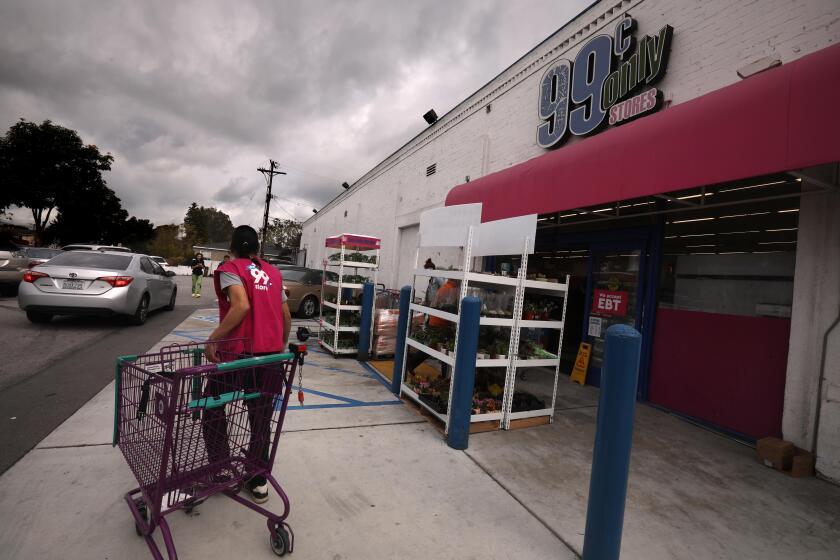Opinion: Court ruling could lead to more pay-TV services, but limited ones
A surprising preliminary ruling by a federal judge in Los Angeles could usher in a new generation of pay TV services online, giving new hope to companies such as the ill-fated Aereo.
Don’t get too excited. The ruling is tentative and so sharply at odds with other holdings, it may not survive on appeal. Even if it does, the services it enables would be limited to local broadcast channels. And if the Federal Communications Commission characterizes the new services as “multichannel video programming distributors,” as it seems poised to do, they may have trouble lining up the local channels that most of their customers want to watch.
At issue is how to treat services that enable customers to tune in their local broadcast TV programs through a remote antenna, then transmit the shows to their homes via the Internet. The best-known example is Aereo, which set up hundreds of tiny antennas in selected cities for customers to capture and record TV signals there.
Broadcasters sued Aereo for copyright infringement, noting that Congress had rewritten the law in 1976 to apply specifically to early versions of cable TV and other shared-antenna services. The Supreme Court ultimately agreed, calling Aereo “for all practical purposes a traditional cable system” that could not retransmit the broadcasters’ programs without a license.
Since then, broadcasters have sought to shutter an Aereo-like service by FilmOn, which also launched without licenses. But the Supreme Court’s ruling against Aereo prodded FilmOn to pursue a new legal argument that just may be its salvation.
Congress made a second change in 1976 that was aimed at those early shared antenna services. It set up a statutory licensing system that automatically authorized cable systems to retransmit local broadcasters’ signals, provided that the broadcasters were paid the royalties specified by the government.
Three years ago, the 2nd Circuit Court of Appeals in New York held that ivi.tv, a pay-TV service that transmitted local broadcasts through the Internet, wasn’t eligible for such a statutory license. After the Supreme Court called Aereo a cable system in everything but name, FilmOn asserted that it was entitled to statutory licenses and started depositing royalty payments at the U.S. Copyright Office. A judge in New York rejected that theory, citing the ivi.tv ruling.
The broadcasters and FilmOn nevertheless have continued their legal battle in federal court in Los Angeles, and that’s where District Judge George H. Wu’s tentative ruling comes in. According to Wu, the 2nd Circuit was wrong about pay-TV services that used the Internet. Under the 1976 law, Wu wrote, the only requirements were that the service provider have facilities in the United States that received broadcast TV signals and retransmitted them over “communications channels” to paying subscribers. FilmOn’s antennas were clearly facilities, and the Internet is undeniably a communications channel, Wu asserted.
Recognizing that his ruling is significant and conflicts with opinions from other federal courts (and the Copyright Office, which has declared that online TV retransmission services aren’t eligible for statutory licenses), Wu put it on hold pending an appeal to the 9th Circuit. He also left a preliminary injunction against FilmOn in place.
I won’t speculate on the ruling’s chances of surviving on appeal, other than to note that the 9th Circuit has been more sympathetic over the years to copyright owners than to alleged infringers. Still, it’s interesting to consider what might happen if the ruling stands.
For starters, we might see a lot more services like Aereo and FilmOn, where a company aggregates local broadcast signals and retransmits them over the Internet. Granted, a service with none of the major cable networks (such as ESPN or HBO) wouldn’t prompt may consumers to cut their cable cords. On the other hand, the country’s largest cable TV operator, Comcast, just announced a low-cost online service consisting of local broadcast channels, so at least one big player believes there’s a real market for such a service.
The FCC, however, could throw another hurdle in the path of FilmOn and its imitators.
The FCC announced in December that it was considering making the definition of “multichannel video programming distributor” technology-neutral, meaning that online pay-TV services could qualify. The goal is to promote competition with cable by making it easier for online services to obtain the rights to ESPN, HBO and the other channels that cable and satellite TV operators carry.
As things stand today, FilmOn and its ilk are not MVPDs, so all they need to obtain is a statutory license in order to retransmit local channels. But if they become MVPDs, by law they’ll also need to get the broadcasters’ permission to carry their signals, and to negotiate a licensing fee. The only obligation for the broadcasters is that they negotiate in good faith.
The “retransmission consent” fees are likely to be much higher than the statutory licensing rates. Conceivably, broadcasters could demand prohibitively high fees if they’re not persuaded that an online service can guard against piracy or stop subscribers in one city from watching TV signals from another. (Stations negotiate exclusive deals for the programming and advertising in their markets, which is why they’re so eager to guard against out-of-market signals.)
At the same time, there’s a growing interest among consumers in narrower, more affordable pay-TV offerings. Similarly, there’s a clear demand for the flexibility and control that streaming services provide.
A number of broadcast and cable networks, such as CBS and HBO, have tried to capitalize on that demand by offering their live feeds online on an a la carte basis. It seems more likely, though, that consumers who want to watch broadcast TV through the Internet will want to buy a package of channels, not pay for them one by one.
So it’s reasonable to expect that momentum will keep building for pay-TV services online, whether it be bundles of cable networks such as Dish’s Sling TV, packages of broadcast channels such as Comcast’s Stream or broader collections such as Hulu. The biggest missing piece today is live streams from local broadcasters, which is the niche FilmOn, like the now-defunct Aereo, is trying to fill. Wu’s decision could add to that momentum if it survives appeal and the FCC’s rulemaking. Granted, that’s a big if.
Follow Healey’s intermittent Twitter feed: @jcahealey
More to Read
A cure for the common opinion
Get thought-provoking perspectives with our weekly newsletter.
You may occasionally receive promotional content from the Los Angeles Times.







